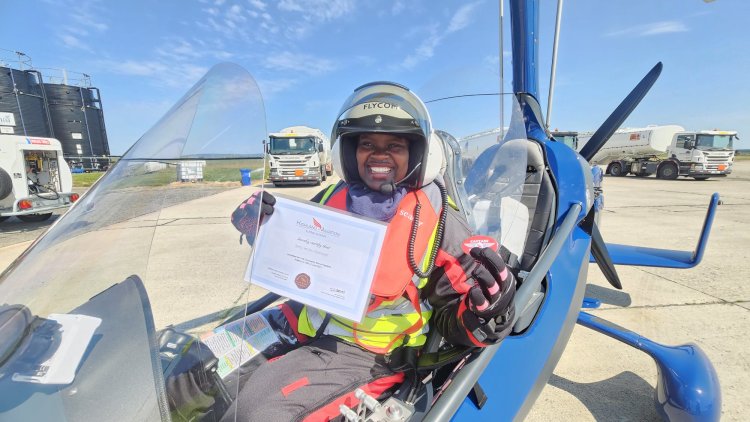Gyrocopter: Meet First Kenyan Woman To Fly Special Aircraft
Jerono flies a gyrocopter, also called an autogyro or gyroplane. It looks like a small helicopter but the main difference is there is no engine turning the main rotor.

In another episode of women breaking boundaries in the world of aviation, Betty Jerono made history by becoming the first Kenyan woman to hold the license of a unique type of helicopter.
Jerono flies a gyrocopter, also called an autogyro or gyroplane. It looks like a small helicopter but the main difference is there is no engine turning the main rotor.
The rotor simply self-propels (autorotate) due to the way the air flows through it. This, together with a very short landing roll, means that a gyrocopter is one of the safest machines for flying.
Jerono flies the special plane for the Kenya Wildlife Service (KWS), which issued a statement on Thursday, September 28 dedicated to her, KWS' first female pilot.

Gyrocopter pilot Betty Jerono. /KWS
"In June 2020, Rubani Jerono embarked on an incredible journey with the Kenya Wildlife Service (KWS) as a trainee pilot, carrying her dreams high above the clouds.
"Her vision? To safeguard our breathtaking wildlife and protected areas from a unique vantage point," read the statement in part.
Her pursuit of excellence took her all the way to the picturesque landscapes of Scotland, where she underwent an intensive 3-month training program at Highland Aviation.
She joined KWS in 2020 as a trainee pilot prior to piloting the gyrocopter to assist in routine monitoring, surveillance, and the management of the country’s wildlife. Prior to joining KWS, she was a pilot at Wilson Airport for one year and three months.
Additionally, she graduated from Moi University in 2018 with a Bachelor’s degree in Aerospace Science.
Now, as a licensed Gyrocopter pilot, Jerono is a vital part of the KWS team, using this remarkable aircraft to assist in routine monitoring, surveillance, and the management of Kenya's precious wildlife.
What Are Gyrocopters?
Gyrocopters are low-flying aircraft that assist in wildlife surveillance in protected areas. They first appeared in 1923 and enjoyed some years of popularity until Helicopters took over the scene during World War II, which led to most of the people forgetting about gyroplanes.
They use an unpowered rotor in autorotation to develop lift, and an engine-powered propeller, similar to that of a fixed-wing aircraft, to provide thrust.
While similar to a helicopter rotor in appearance, the rotor blades of a gyroplane are not powered. The rotor turns because of the passage of air through the rotor from below.
A separate engine/propeller provides forward thrust. In the event of an engine failure, the gyroplane will descend, but the main rotor blades will continue to rotate and provide lift due to the continued airflow through them.
Throughout the flight, the gyroplane is therefore in a continuous state of autorotation and behaves similarly to a fixed-wing aircraft, except that its wing rotates.

Betty Jerono operating a gyrocopter. /KWS
KWS Aircraft
KWS is known for its exclusive status as the only institution in the country licensed by Kenya Civil Aviation to maintain aircraft from both the public and private sectors. The parastatal has an airwing section, based at Wilson Airport, with over 40 pilots to provide air support services to wildlife management across the country.
It boasts a fleet of over 15 aircraft and four hangars in Meru, Kamboyo in Tsavo West National Park, Mweiga in Aberdares, Nyeri and Wilson Airport.
KWS pilots have a wide array of specialized skills including veterinary support services for research and translocation purposes, animal tracking, wildlife census, firefighting, rescue work, and transportation of rations and supplies, including ammunition.
Since the flyers are constantly on standby to fly anywhere across all the conservancies, they have to be well-versed in the terrain as well as Kenya's wildlife to be able to navigate in case of emergencies or difficult weather conditions.

 admin
admin 




